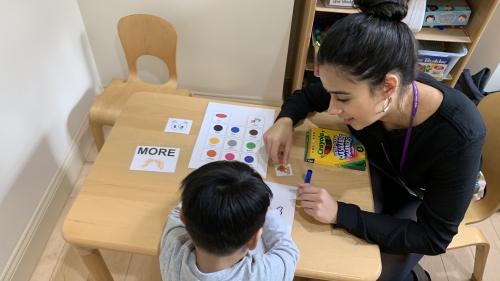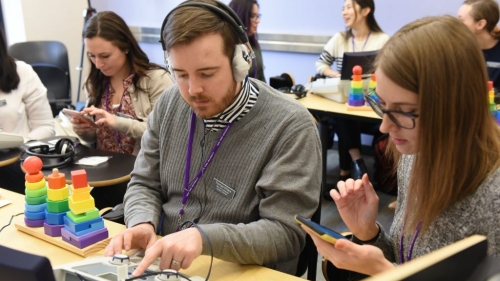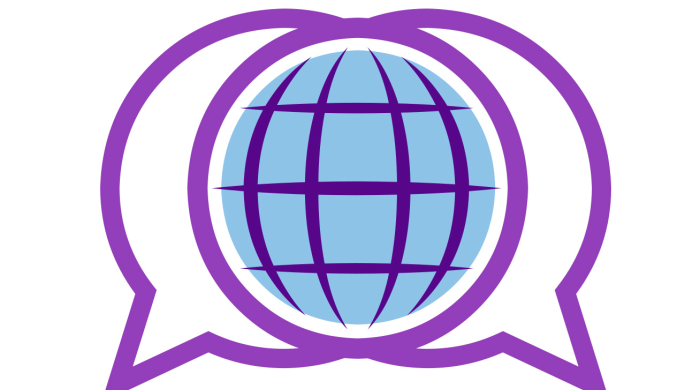
As a graduate student clinician, Paola provides individual speech therapy services as well as group reading sessions.
Meet Paola Ocampo, a master’s student in the NYU Steinhardt Department of Communicative Sciences and Disorders (CSD). She is also a student in the NYU CSD Bilingual Extension Program, a supplemental opportunity for aspiring bilingual speech-language pathologists (SLPs) to develop the skills needed to evaluate and treat clients using culturally- and linguistically-sustaining practices.
Paola has now spent two semesters working as a graduate student clinician with bilingual preschoolers at the Lenox Hill Neighborhood House Early Childhood Center, a free, year-round program that prepares children of low-income families living on the East Side of Manhattan to excel in school. We connected with Paola to learn more about her desire to become a bilingual SLP and her experience working with students at Lenox Hill through NYU CSD's partnership with the Early Childhood Center.
What inspired you to study speech-language pathology in the first place?
My language experience is beautifully complex. In the first grade, I learned English as a second language while simultaneously serving as a Spanish interpreter for my Colombian mother. I was disheartened when my mother was too often neglected by those who could not “understand” her. I became sensitive to moments where people cannot communicate and are thus often ostracized. I am inspired to pursue speech-language pathology as a career in order to dismantle barriers in communication that multilingual children and families face. I am passionate about researching and implementing culturally responsive practices that serve and advocate for culturally and linguistically diverse individuals and their families.
You’ve been bringing that passion to working with preschoolers at Lenox Hill for two semesters now. What kinds of services do you provide these students?
A group of graduate clinicians under the supervision of Clinical Assistant Professor Alisha Gandhi attended Lenox Hill Neighborhood House Child Center once a week for an hour and a half before the pandemic. The first 30 minutes were spent in a classroom where we facilitated a weekly reading lesson. These “read alouds” focused on teaching specific vocabulary, concepts, and encouraging physical movement. Afterward, we facilitated an “after activity” usually involving a craft the students could take home. For example, one week we read Pete the Cat: Go, Pete, Go and facilitated a lesson on types of transportation. After the reading, we facilitated a craft activity where students colored their own race cars and race tracks.
In addition, we provided individual speech therapy services. I personally provided speech services to a 3-year-old bilingual boy where, under the supervision of professor Gandhi, I worked on goals targeting increases in expressive language and communication in both English and Spanish in the context of both structured play and routines.

Paola reading a story about “Pete the Cat” in both English and Spanish during a remote session with Lenox Hill students.
What techniques do you use to engage your students now that you’re working with them remotely?
Lenox Hill Neighborhood House Early Childhood Center embraced an online modality where we graduate students were able to use Zoom to continue providing weekly speech-language services through our interactive “read alouds” to students. Now we plan weekly interactive sessions and activities using children’s books found online and on YouTube. We reinforce vocabulary and context-specific concepts before, during, and after reading and facilitate corresponding activities on topics like counting, learning adjectives, and using critical thinking to make predictions about what events will occur next in a story.
In order to encourage students to interact with the “read alouds” both in person and online, we incorporate choral reading where we repeat phrases and sounds in unison as well as pair motions to key vocabulary. Some of the themes we have covered recently include camping, animals, insects, and the ocean, which pair well with movement and choral reading and are fun topics for children who live in cities to learn about.
What has been the most rewarding part of participating in this programming? Do you have a favorite memory of working with these students?
Being a part of this initiative is truly a gift and I am honored to be one of the graduate students who contributes to the wonderful work that takes place at the Lenox Hill Neighborhood House Early Childhood Center. These unprecedented times have been difficult for our young students as they miss their friends and their teachers. I love jumping on Zoom every week and watching how they greet each other and show each other their toys. It is gratifying and humbling to know we can do our small part in helping caregivers bring a sense of normalcy to their children and their homes.
A favorite memory I have from working at Lenox Hill Neighborhood House Child Center is when my colleague and I witnessed our three-year-old student communicate independently using sign-language to request more toys. This was a skill she had been working on for over two semesters.
“[Two students] started the year uncomfortable with their speech, very quiet and reserved, scared to socialize with their peers because they didn’t know how to advocate for themselves. Through [the] work with our NYU partners, they flourished. They grew into their own personalities, started sharing out, interacting with classmates, and ended the year ready for their next adventure.”
What advice do you have for CSD students beginning to work in the field?
I truly believe that we are lucky to get to do the work that we do. My advice for CSD students starting their clinical experiences is to be flexible – as we transition into learning how to provide services through telepractice, it is important that we view these experiences as opportunities to cultivate new clinical skills and channel our creativity. Lastly, listen and advocate for each of your clients and their families as you have the opportunity to help them discover empowerment in their communication.
About the Bilingual Extension

Communicative Sciences and Disorders
665 Broadway, 9th floor
New York, NY 10012
Phone: 212-998-5230

